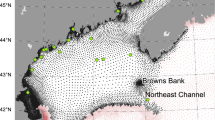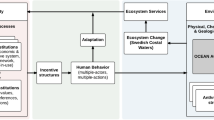Abstract
It is widely accepted that excess nutrients change the dissolved inorganic carbon (DIC) system, which drives air–sea carbon dioxide (CO2) exchanges, so the changes in the DIC system will then affect the oceans’ carbon (C) biogeochemistry cycle. This study explores the impact of external nutrient input from 2006 to 2011 on the DIC system and air–sea CO2 exchanges in four largest coastal seas in China. The result demonstrates that external nutrient input significantly facilitates the biological uptake of DIC and promotes air–sea CO2 fluxes in coastal waters. The C sink caused by nitrogen (N) and phosphorus (P) input for the Bohai Sea, the Yellow Sea, the East China Sea, and the South China Sea account for 46, 45, 11, and 59 % of the total C sink, respectively. The excess nutrient input significantly changes the DIC system and C biogeochemistry cycle process in China Ocean. Up to a certain point, these effects are positive in increasing DIC levels and enhancing air–sea CO2 exchanges. However, the DIC levels may decrease if the nutrient increase is greater than the capacity of the oceanic C system. In addition, the other impact factors, including sea level, winds, water, and air temperatures, and various human activities, such as agriculture, industry, and domestic discharge, also affect N and P transport, air–sea CO2 fluxes, and C biogeochemistry cycles.







Similar content being viewed by others
References
Bakker DCE, de Baar HJW, de Jong E (1999) The dependence on temperature and salinity of dissolved inorganic carbon in East Atlantic surface waters. Mar Chem 65:263–280
Baliño BM, Fasham MJR, Bowles MC (2001) Ocean biogeochemistry and global change. The International Geosphere-Biosphere Programme: A Study of Global Change of the International Council for Science (ICSU), Stockholm, Sweden
Bouillon S, Borges AV, Castaneda-Moya E (2008) Mangrove production and carbon sinks: a revision of global budget estimates. Glob Biogeochem Cycles 22(2):GB2013
Carstensen J, Sánchez-Camacho M, Duarte CM, Krause-Jensen D, Marba N (2011) Connecting the dots: responses of coastal ecosystems to changing nutrient concentrations. Environ Sci Technol 45:9122–9132
Chen CTA, Liu KK, Macdonald R (2003) The role of the ocean carbon cycle in global change. In: Fasham MJR (ed) Ocean biogeochemistry, chapter 3 continental margin exchanges. Springer, Berlin
Cunha LC, Buitenhuis ET, Le Quéré C, Giraud X, Ludwig W (2007) Potential impact of changes in river nutrient supply on global ocean biogeochemistry. Glob Biogeochem Cycles 21:GB4007
del Giorgio PA, Duarte CM (2002) Respiration in the open ocean. Nature 420:379–384
Díaz RJ, Rosenberg R (2008) Spreading dead zones and consequences for marine ecosystems. Science 321:926–929
Doney SC, Mahowald N, Lima I, Feely RA, Mackenzie FT, Lamarque JF, Rasch PJ (2007) Impact of anthropogenic atmospheric nitrogen and sulfur deposition on ocean acidification and the inorganic carbon system. Proc Natl Acad Sci USA 104(37):14580–14585
Duarte CM (1995) Submerged aquatic vegetation in relation to different nutrient regimes. Ophelia 41:87–112
Duarte CM, Cebrian J (1996) The fate of marine autotrophic production. Limnol Oceanogr 41(8):1758–1766
Falkowski P, Scholes RJ, Boyle E, Canadell J, Canfield D, Elser J, Gruber N, Hibbard K, Högberg P, Linder S, Mackenzie FT, Moore B III, Pedersen T, Rosenthal Y, Smetacek V, Steffen W (2000) The global carbon cycle: a test of our knowledge of earth as a system. Science 290:291–296
Fang JY, Liu GH, Xu SL (1996) Carbon cycles of Chinese terrestrial ecosystems and their global significances. In: Wang GC, Wen YP (eds) Greenhouse gases and their emission monitoring and some relative processes. China Environmental Science Press, Beijing, pp 129–139
Ferial L, Diana PRP, Catherine J, Christian B, Bernard S, Annick M, Michel F, Alain P (2001) Dissolved inorganic carbon, alkalinity, nutrient and oxygen seasonal and interannual variations at the Antarctic Ocean JGOFS-KERFIX site. Deep Sea Res (I) 48:1581–1603
Foley JA, DeFries R, Asner GP, Barford C, Bonan G, Carpenter SR, Chapin FS, Coe MT, Daily GC, Gibbs HK, Helkowski JH, Holloway T, Howard EA, Kucharik CJ, Monfreda C, Patz JA, Prentice IC, Ramankutty N, Snyder PK (2005) Global consequences of land use. Science 309:570–574
Fonfonoff P, Millard RC (1983) Algorithms for computation of fundamental properties of seawater, UNESCO Technical Papers in Marine Sciences, pp 44–53
Frankignoulle M, Abril G, Borges A, Bourge I, Canon C, Delille B, Libert E, Théate JM (1998) Carbon dioxide emission from European estuaries. Science 282(16):434–436
Galloway JN, Cowling EB (2002) Reactive nitrogen and the world: two hundred years of change. Ambio 31:64–71
Gao Y, Zhu B, Wang T, Wang YF (2012) Seasonal change of non-point source pollution-induced bioavailable phosphorus loss: a case study of Southwestern China. J Hydrol 420–421:373–379
Gao Y, Zhu B, Yu GR, Chen WL, He NP, Wang T, Miao CY (2014a) Coupled effects of biogeochemical and hydrological processes on C, N, and P export during extreme rainfall events in a purple soil watershed in southwestern China. J Hydrol 511:692–702
Gao Y, Zhu B, He NP, Yu GR, Wang T, Chen WL, Tian J (2014b) Phosphorus and carbon competitive sorption-desorption and associated non-point loss respond to natural rainfall events. J Hydrol 517:447–457
Glibert PM, Seitzinger S, Heil CA, Burkholder JM, Parrow MW, Codispoti LA, Kelly V (2005) The role of eutrophication in the global proliferation of harmful algal blooms. Oceanography 18:198–209
Global Carbon Project (2010) http://lgmacweb.env.uea.ac.uk/lequere/co2/carbon_budget.htm
González JM, Fernandez-Gomez B, Fendandez-Guerra A, Gómez-Consarnau L, Sánchez O, Coll-Lladó M, Del Campo J, Escudero L, Rodríguez-Martínez R, Alonso-Sáez L, Latasa M, Paulsen I, Nedashkovskaya O, Lekunberri I, Pinhassi J, Pedrós-Alió C (2008) Genome analysis of the proteorhodopsin-containing marine bacterium Polaribacter sp. MED152 (Flavobacteria). Proc Natl Acad Sci USA 105(25):8724–8729
Gypens N, Borges AV, Lancelot C (2009) Effect of eutrophication on air-sea CO2 fluxes in the coastal Southern North Sea: a model study of the past 50 years. Glob Change Biol 15:1040–1056
Han WY, Lin HY, Cai YY (1997) Air-sea CO2 flux in the South China Sea. Oceanography 19(1):50–54 (in Chinese)
Houghton RA (2007) Balancing the global carbon budget. Annu Rev Earth Planet Sci 35:313–347
Hu DX, Yang ZS (2001) The key processes of the air-sea CO2 flux in the East China Sea. Ocean Press, Beijing (in Chinese)
Huertas E, Montero O, Lubián LM (2000) Effects of dissolved inorganic carbon availability on growth, nutrient uptake and chlorophyll fluorescence of two species of marine microalgae. Aquac Eng 22:181–197
Invers O, Pérez M, Romero J (2002) Seasonal nitrogen speciation in temperate seagrass Posidonia oceanica (L.) Delile. J Exp Mar Biol Ecol 273:219–240
Invers O, Kraemer GP, Pérez M, Romero J (2004) Effects of nitrogen addition on nitrogen metabolism and carbon reserves in the temperate seagrass Posidonia oceanica. J Exp Mar Biol Ecol 303:97–114
IPCC (2005) Carbon dioxide capture and sealing. In: Metz B, Davidson O, de Coninck H, Loos M, Meyer L (eds) Cambridge University Press, UK, pp 431
Jiao NZ, Herndl GJ, Hansell DA, Benner R, Kattner G, Wilhelm SW, Kirchman DL, Weinbauer MG, Luo TW, Chen F, Azam F (2010) Microbial production of recalcitrant dissolved organic matter: long-term carbon storage in the global ocean. Nat Rev Microbiol 8(8):593–599
Kevin JF (2005) Modeling marine phytoplankton growth under eutrophic conditions. J Sea Res 54:92–103
Larssen T, Duan L, Mulder J (2011) Deposition and leaching of sulfur, nitrogen and calcium in four forested catchments in China: implications for acidification. Environ Sci Technol 45(4):1192–1198
Liss P, Merlivat L (1986) Air-sea exchange rates, introduction and synthesis. In: Buat-Ménard P (ed) The role of air-sea exchange in geochemical cycling. NATO/ASI Series. D. Reidel, Dordrecht, pp 113–127
Mackenzie FT, Lerman A, Andersson AJ (2004) Past and present of sediment and carbon biogeochemical cycling models. Biogeosciences 1:11–32
Orgeta T, Ponce R, Forja J, Gómez-Parra A (2004) Fluxes of dissolved inorganic carbon in three estuarine systems of the Cantabrian Sea (north of Spain). J Mar Syst 53:125–142
Pipko II, Semiletov IP, Tishchenko PY, Pugach SP, Christensen JP (2002) Carbonate chemistry dynamics in Bering Strait and the Chukchi Sea. Prog Oceanogr 55:77–94
Raven JA, Falkowski PG (1999) Oceanic sinks for atmospheric CO2. Plant Cell Environ 22:741–755
Siegenthaler U, Sarmiento JL (1993) Atmospheric carbon dioxide and the ocean. Nature 365:119–125
Smith VH, Tilman GD, Nekola JC (1999) Eutrophication: impacts of excess nutrient inputs on freshwater marine and terrestrial ecosystems. Environ Pollut 100:179–196
Song JM (2004) Chinese coastal biogeochemistry cycle. Shandong Science and Technology Press, Jinan (in Chinese)
Tsunogai S, Watanabe S, Sato T (1999) Is there a “continental shelf pump” for the absorption of atmospheric CO2? Tellus 51B:701–712
Wanninkhof RH (1992) Relationship between wind speed and gas exchange over the ocean. J Geophys Res C 97:7373–7382
Weiss RF (1974) Carbon dioxide in water and seawater: the solubility of a non-ideal gas. Mar Chem 2:203–205
Xu FL, Tao S, Dawson RW, Li PG, Cao J (2001) Lake ecosystem health assessment: indicators and methods. Water Res 35(13):3157–3167
Zeebe RE, Wolf-Gladrow D (2005) CO2 in seawater: equilibrium, kinetics, isotopes. Elsevier, Amsterdam
Zhang NX (2008) Influence of external source nitrogen and phosphate on inorganic carbon source/sink. Doctoral dissertation
Zhang NX, Song JM, He JP, Li XG, Yuan HM, Li N (2007) Influence of external source nutrient and phosphate on dissolved inorganic carbon system in seawater simulated experiment. Studia Marian Sinica 48:67–75
Zhang NX, Song JM, Cao CH, Ren RZ, Wu FC, Zhang SP, Sun X (2012) The influence of macronitrogen (NO3 − and NH4 +) addition with Ulva pertusa on dissolved inorganic carbon system. Acta Oceanol Sin 31(1):73–82
Zhi YL, Jin XC, Zhong Y (2008) Photosynthetic bicarbonate utilization by the fresh-water, green microalgae Chlorella pyrenoidosa and Scenedesmus obliquus. Acta Scientiae Circumstantiae 28(8):1519–1525 (in Chinese)
Acknowledgments
This work was financially supported by National Nature Science Foundation of China (No. 31200404 and 31290223); and the Program for ‘‘Bingwei’’ Excellent Talents in Institute of Geographic Sciences and Natural Resources Research, CAS. The authors would also like to thank the anonymous reviewers for their helpful remarks.
Author information
Authors and Affiliations
Corresponding author
Additional information
Editor: Jintao Xu.
Rights and permissions
About this article
Cite this article
Gao, Y., He, N., Yu, G. et al. Impact of external nitrogen and phosphorus input between 2006 and 2010 on carbon cycle in China seas. Reg Environ Change 15, 631–641 (2015). https://doi.org/10.1007/s10113-014-0664-2
Received:
Accepted:
Published:
Issue Date:
DOI: https://doi.org/10.1007/s10113-014-0664-2




